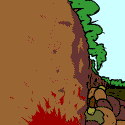|
Blistex posted:I want Japan to remake Iron Chef, but it's wood working. They introduce the general idea for the project, the type of wood, then they have an hour to make it. . . best to have a nurse on standby. https://www.youtube.com/watch?v=x2JYB3jNwpY
|
|
|
|

|
| # ? Jun 4, 2024 01:34 |
|
 My TG Secret Santa received their gift so now I can post about it! They said they always wanted a dice tower so that's what I decided to make. I am getting a better hang of the pallet wood, with heavy abuse of the belt sander I can get everything nice and flush and make it feel like a single smooth piece, rather than a bunch of janky boards glued together: My TG Secret Santa received their gift so now I can post about it! They said they always wanted a dice tower so that's what I decided to make. I am getting a better hang of the pallet wood, with heavy abuse of the belt sander I can get everything nice and flush and make it feel like a single smooth piece, rather than a bunch of janky boards glued together:     Gluing the angled corner flaps on the interior of the dice tower was interesting, but I managed. It was a fun learning experience. I am going to make another one I think for a friend in another city. Rutibex fucked around with this message at 05:50 on Nov 28, 2020 |
|
|
|
Have any of ya'll tried those new Stanley Sweetheart planes? Are they square? Are they worth a drat? I need a low angle jack plane.
|
|
|
|
osker posted:Have any of ya'll tried those new Stanley Sweetheart planes? Are they square? Are they worth a drat? I need a low angle jack plane. Hit or miss. I returned 3 due to assorted defects before giving up and keeping my money, my brother's was perfect out of the box. Looking at the Amazon reviews, that seems to be the general theme.
|
|
|
|
osker posted:Have any of ya'll tried those new Stanley Sweetheart planes? Are they square? Are they worth a drat? I need a low angle jack plane. If you want a low angle, get the Veritas/Lee Valley. It has all the design problems worked out vs any other, and isn't horrifyingly expensive. The Lie Nielsen low angle is a close second. That said, I have the Veritas jack and bevel up smoother and while they're really truly excellent, it's not the glorious dream of "HAH, I'll just get extra irons and swap them to high angle for difficult grain, it's the only plane I need" that they're billed as. It's a wonderful first/main bench plane and crazy versatile, but it's not a silver bullet. Hypnolobster fucked around with this message at 07:38 on Nov 28, 2020 |
|
|
|
dangling pointer posted:How did you guys transition into making more refined (intricate?) projects? My advice is for each new project you make to incorporate about one new technique. Practice that technique at least once or twice in scrap before you try it for real. The first time will teach you a lot, then keep practicing until you feel you're ready to do it for real (but don't over-do the practicing; just build the drat thing). Then you'll have that technique in your library for the next project, and you'll build up a library of techniques you can use when you're designing your pieces. I think a table is a great beginner project: it teaches you about keeping stuff flat and square, and the joinery is just basic mortise and tenon, which is a very forgiving joint, especially if you pin or drawbore it. Once you've got M&T in your library, you can basically build most arts & crafts style furniture. Or, move on to casework and learn about dovetails and dadoes. That then relates to this guy's question: AAAAA! Real Muenster posted:But I have one big question: What are the essential basic tools I need to get started? Buy what you need to make what you want, how you want, and nothing else. There isn't a list of essential tools because it'll be different for everyone. I consider my No 8 handplane essential because I'm a nutjob who does all my stock prep with hand tools. You may want a planer. Or maybe you just start with pre-surfaced wood and can skip all that until later. Instead, figure out what you want to make, and how you want to make it (watch a lot of YouTube; buy a lot of books), and then go buy those tools. Then as you incorporate new techniques, you'll find you need new tools to do them. You don't need a router plane to build a table, but you will need a router plane to cut hinge mortises for a door. Basically just get started and fill in what you're missing as you expand your repertoire. All that said, here was my beginner kit: http://www.smokingonabike.com/2017/01/01/hand-tools-for-a-newbie-woodworker/ E: Also worth mentioning, I built my first few projects by clamping stuff to a sheet of plywood. It's not a great way to work, but not having a bench doesn't need to be an impediment to your first few projects. A bench is a fairly intimidating first project. ColdPie fucked around with this message at 15:02 on Nov 28, 2020 |
|
|
|
Yeah I still don't have a workbench, mostly because I do all of my woodworking in the back yard. I'm up to two reinforced sheets of plywood on sawhorses for work surface! I'd kill for a workshop or garage or basement or really anything indoors but all I've got is a shed, a rain canopy, and a table saw that lives outside
|
|
|
|
ColdPie posted:My advice is for each new project you make to incorporate about one new technique. Practice that technique at least once or twice in scrap before you try it for real. The first time will teach you a lot, then keep practicing until you feel you're ready to do it for real (but don't over-do the practicing; just build the drat thing). Then you'll have that technique in your library for the next project, and you'll build up a library of techniques you can use when you're designing your pieces. I'm not a good woodworker, but this has been my approach. If I want to try something out I'll just shoehorn it into a project where it's not required but won't gently caress anything up (shop furniture or whatever). I've also found that even if I think I have everything I need I will end up at the hardware store for some specific screw or t-nut or bracket or bit or whatever anyway. I will say that beyond the basics like some clamps etc, the one thing I couldn't live without as someone who is bad at making things line up perfectly all of the time is a decent sanding block (not the foam kind, the kind you can attach any quarter-sheet you want to) and my cheap rear end ($30 on sale or something?) orbital sander.
|
|
|
|
It's unfortunate that a good, big workbench with vises is a relatively complicated thing to build and expensive to buy, because it is the thing that every beginning woodworker should have access to and it does more to make woodworking easy and pleasant than just about any other toolSono posted:
Kaiser Schnitzel fucked around with this message at 17:22 on Nov 28, 2020 |
|
|
|
Oh hey, the educational opportunities I never got. Neat. I'm not jealous, you're jealous.
|
|
|
|
Kaiser Schnitzel posted:It's unfortunate that a good, big workbench with vises is a relatively complicated thing to build and expensive to buy, because it is the thing that every beginning woodworker should have access to and it does more to make woodworking easy and pleasant than just about any other tool Agreed, but you can totally get by with a pretty simple one like Rex Krueger's $30 bench. That (and I didn't even put the legs in, it's just glued up 2x4s sitting on kitty litter bins) with a cheap vise from Menards bolted to the end and a 3/4" holes drilled through it is all I've been using for over a year. ColdPie posted:All that said, here was my beginner kit: http://www.smokingonabike.com/2017/01/01/hand-tools-for-a-newbie-woodworker/ You're in the twin cities right? Where do you find older tools locally (like that #8)? I check craigslist every now and then but not much shows up there. Elder Postsman fucked around with this message at 17:38 on Nov 28, 2020 |
|
|
|
I've had a nice elm slab that has been sitting on hairpin legs for a few years now, and thought it deserved something a little nicer, so I made a Nakashima style base out of 8/4 cherry. It came out pretty good, and I was able to add a tiny hidden 1" tall drawer just under the top for remote controls and coasters. This was a pretty fun build--surprisingly not too difficult given that almost nothing is 90 degrees, but needed to plan the order of cuts carefully to avoid cutting something was going to be used as a reference surface later. 
|
|
|
|
Beautiful! In regards to the beginner woodworking kit, get Japanese pull saws over European ones. They're stupid sharp, thin kerf, and surprisingly inexpensive.
|
|
|
|
Elder Postsman posted:You're in the twin cities right? Where do you find older tools locally (like that #8)? I check craigslist every now and then but not much shows up there. Yup. I actually found that one on Craigslist, years ago. If you're in MWTCA you can go to their tool events... maybe at the end of next year. Almost everything I've bought has been from eBay though.
|
|
|
|
Discomancer posted:I've had a nice elm slab that has been sitting on hairpin legs for a few years now, and thought it deserved something a little nicer, so I made a Nakashima style base out of 8/4 cherry. It came out pretty good, and I was able to add a tiny hidden 1" tall drawer just under the top for remote controls and coasters. This was a pretty fun build--surprisingly not too difficult given that almost nothing is 90 degrees, but needed to plan the order of cuts carefully to avoid cutting something was going to be used as a reference surface later.  I find the geometry of this to be very pleasing.
|
|
|
|
How do I go about identifying a type of wood? I had to put a hole though the floor in my 1830s house and ended up with a chunk of the old floorboards that are beneath the laminate and carpet. I sanded the top down and applied a little linseed oil to see how it looks, but now I'm curious what kind of wood it is. First picture is the sanded & oiled top, second is the underside. 
|
|
|
|
What does it smell like?
|
|
|
|
Doesn't smell like anything to me, but I have a bad sense of smell.
|
|
|
|
Toebone posted:How do I go about identifying a type of wood? I had to put a hole though the floor in my 1830s house and ended up with a chunk of the old floorboards that are beneath the laminate and carpet. I sanded the top down and applied a little linseed oil to see how it looks, but now I'm curious what kind of wood it is. First picture is the sanded & oiled top, second is the underside. It's pine of some sort (not a yellow pine), maybe fir. Softwoods can be a bit hard to ID very specifically. This website has some good info: https://www.wood-database.com/wood-articles/ There is also a book called 'Identifying Wood' by Bruce Hoadley, but most wood ID is seeing a wood you know is white oak, and then remembering what it looks like and so next time you see it you know. The US Forest Service or Forest Products Laboratory probably has some publications on it online for free if you google around.
|
|
|
|
Toebone posted:How do I go about identifying a type of wood? I had to put a hole though the floor in my 1830s house and ended up with a chunk of the old floorboards that are beneath the laminate and carpet. I sanded the top down and applied a little linseed oil to see how it looks, but now I'm curious what kind of wood it is. First picture is the sanded & oiled top, second is the underside. Where do you live? Being in a house that old, it's very much a native/local timber. It looks like some kind of fir.
|
|
|
|
Hypnolobster posted:Where do you live? Being in a house that old, it's very much a native/local timber. It looks like some kind of fir. The oods are good. Virtually everything I've seen in the US from the 19th century is old growth fir.
|
|
|
|
Hypnolobster posted:Where do you live? Being in a house that old, it's very much a native/local timber. It looks like some kind of fir. Northern New Jersey
|
|
|
|
ColdPie posted:Yup. I actually found that one on Craigslist, years ago. If you're in MWTCA you can go to their tool events... maybe at the end of next year. Almost everything I've bought has been from eBay though. Hah, welp, guess I'll just keep doing what I'm doing then.
|
|
|
|
Elder Postsman posted:You're in the twin cities right? Where do you find older tools locally (like that #8)? I check craigslist every now and then but not much shows up there. I put up search alerts on Craigslist, OfferUp and FB Marketplace, and pounce when they pop up for decent deals.
|
|
|
|
So, I'm going to be dropping a fairly hefty inlay into a tree round. Despite many years of wood dickery, this is new to me. For the glue up, can I get away with using wood glue, or should I be using epoxy? It only just occurred to me that all the mating surfaces will be end grain to face grain.
|
|
|
|
Discomancer posted:I've had a nice elm slab that has been sitting on hairpin legs for a few years now, and thought it deserved something a little nicer, so I made a Nakashima style base out of 8/4 cherry. It came out pretty good, and I was able to add a tiny hidden 1" tall drawer just under the top for remote controls and coasters. This was a pretty fun build--surprisingly not too difficult given that almost nothing is 90 degrees, but needed to plan the order of cuts carefully to avoid cutting something was going to be used as a reference surface later. Suntan Boy posted:So, I'm going to be dropping a fairly hefty inlay into a tree round. Despite many years of wood dickery, this is new to me. For the glue up, can I get away with using wood glue, or should I be using epoxy? It only just occurred to me that all the mating surfaces will be end grain to face grain.
|
|
|
|
Thank you for all the replies everyone!Jhet posted:This is a good place to start... TooMuchAbstraction posted:Generally I would say, buy the tools you need to do your next project. You don't want to buy stuff that you don't end up using. Plus, this means more shopping trips and more "yay I got a new tool" Christmas joy Olothreutes posted:I would say no fewer than four clamps to start, they are way more useful than I thought they would be. I recently got four more pipe clamps which are whatever size I need and that's cool. I need to start on some bigger projects soon. Rutibex posted:I put a shop togeather over the course of 2020 lockdown so I can give you a list of the stuff I obtained... ColdPie posted:Buy what you need to make what you want, how you want, and nothing else. There isn't a list of essential tools because it'll be different for everyone. I consider my No 8 handplane essential because I'm a nutjob who does all my stock prep with hand tools. You may want a planer. Or maybe you just start with pre-surfaced wood and can skip all that until later. Instead, figure out what you want to make, and how you want to make it (watch a lot of YouTube; buy a lot of books), and then go buy those tools. Then as you incorporate new techniques, you'll find you need new tools to do them. You don't need a router plane to build a table, but you will need a router plane to cut hinge mortises for a door. Basically just get started and fill in what you're missing as you expand your repertoire.  http://www.smokingonabike.com/2017/01/01/hand-tools-for-a-newbie-woodworker/ http://www.smokingonabike.com/2017/01/01/hand-tools-for-a-newbie-woodworker/I'll probably start with simple lumber because I'm planning building the bare necessity to get practice then I will build it again once I improve my technique and figure out improvements I can make to the first design.
|
|
|
|
I think part of it is that there's a lot of ways to skin a cat. I'm planning on building a computer desk with some mortise and tenon joinery and a set of drawers. I expect to use my router table and table saw extensively, as well as my miter saw, a chisel or two, a drill, a tape measure, a speed square, maybe one of those nifty looking measuring marking thingys for mortise and tenon stuff, a block plane, a smattering of bar and pipe clamps, and a random orbit sander. This is by no means a comprehensive list of things I will probably touch at one point or another, nor is it a minimum viable set of tools - it's largely driven by what I happen to have, techniques I'm comfortable with (or want to learn - never done m&t before nor glued up a panel of boards). I have a general approach in mind that's largely drawn from / inspired by a few youtubers I like on the topic (woodworking for mere mortals for "how do I do x" and ishitani furniture for inspiration and "wow it would be cool to try, and gently caress up, doing y")
|
|
|
|
I'm putting together a detailed cad design of what I want to build, and for every single part in it I ask myself - how will I turn a piece of stock into that shape with good enough tolerances to look and feel good? Do I have the tools and skills to do that? Do I want to expand my skills and tools to do that, or do I want to take a different approach in the design?
|
|
|
|
What’s the best way to cut 4x4 wood without a table saw? I have a lot of trouble keeping handsaw cuts that deep straight, and my circular saw is only 7 1/2”. Would it work to make two passes with the circular saw on opposite sides? e: or even three cuts? I.E. make a cut across on side, turn 90 degrees to keep the same kerf, turn 90 degrees again to finish the cut Bouillon Rube fucked around with this message at 23:27 on Nov 29, 2020 |
|
|
|
Rock My Socks! posted:What’s the best way to cut 4x4 wood without a table saw? That's what I've ended up doing.
|
|
|
|
AAAAA! Real Muenster posted:Thank you for the links! My reply to TooMuchAbstraction mentions this, but just try to add more info... I know I want to build myself a big sturdy standing computer desk, but I am ignorant of what specific things I may need to build it. I have a plan drawn out on paper and a circular saw, a simple level, and old handsaw, and thats it - I have no idea if there would be good tools I could buy to help me that I just dont know about. The list you have at this link is So for a basic table with a drawbored mortise-and-tenon frame, you'd want something to: Cut all boards to length (handsaw, tablesaw, or circular saw) Flatten all boards (hand planes, or jointer and planer) Joint the top boards (hand planes, or jointer) Join the top boards (clamps, about one per foot of length) Flatten the top after jointing if needed (hand planes, wide belt sander, or super wide planer??) Square the legs (hand planes, jointer and/or planer) Lay out joinery (knife, pen, or pencil; straightedge, square, marking gauge, measuring tape) Cut mortises in the legs (mortising chisel or bevel edge chisel, mallet; power drill, drill press, or mortising machine) Cut tenons in the aprons (backsaw, tablesaw, or bandsaw; rabbet plane, chisel) Drill drawbore holes (power drill, or hand drill) Drive drawbores (mallet) Apply finish (brushes, rags, or spraying setup) Cut tabletop buttons (backsaw, bandsaw, tablesaw, rabbet plane, or just go buy figure-eights) Cut tabletop button mortises (mortising chisel or bevel edge chisel, mallet; mortising machine) Drill tabletop button pilot holes (power drill, or hand drill) Drive screws (screwdriver, or power drill) You can see there's a ton of options for every operation. What tools you want to get will depend on how you like to work, which is why we're having a hard time answering your question directly. You can also skip some of the steps by buying pre-made components, like a wooden tabletop from the home center. Or skip the M&T joinery entirely and do pocket screws or metal corner hardware or something. Find a woodworking method that looks appealing to you. Watch some YouTube, read some books. The Taunton books mentioned in the OP are excellent overviews of joinery and furniture design options (you can get digital versions of those books included with a Fine Woodworking Unlimited subscription). You will learn a ton about how you like to work with your first project, so I'd say don't be afraid to just dive in and figure out what feels right and wrong to you. It's the only way to learn. If what you're doing isn't working for you, that's an indicator it might be time to buy a different tool to do it another way.
|
|
|
AAAAA! Real Muenster posted:Perfect, thank you. This is probably on the other, more comprehensive lists that others posted but I thought about what else I have around from other various projects that I take for granted. I have a miter saw from probably a decade ago, it goes largely unused these days and anything I can do with it I could also do with a hand saw with little trouble. I have a circular saw that I use a lot more. I would like a proper fence to go with it for long cuts, but for the moment I can do things like clamp my level to the workpiece because I know it's straight. I have a bow saw, a coping saw, dozuki, and like three "regular" hand saws that came in the shed when I bought my house. I (ab)use the dozuki for most things. Random orbital sander and discs. Sanding is way more important than I realized when I first got started. There's enough that having a powered sander is probably worthwhile for anything that isn't elf staircase sized or smaller. For a decade or more I had a cordless drill that I used as both a drill and a driver. I recently upgraded because the batteries were toast and got a drill and driver combo kit. It is so, so nice to be able to drill a pilot hole and then just drive the screw in without having to open the chuck, remove the bit, insert the driver bit, etc. Just pick up the other tool and go. Highly recommend having both. It's absolutely possible to do it with just a drill, but having seen the light I wouldn't recommend it. If you plan to use screws for a lot beyond pocket screws maybe get a countersink bit. Screw heads just sticking out is a hazard in addition to being unsightly, and trust me you can't really fake having one by drilling a recess for the screw head with a larger bit. All you get is a bunch of tearout and disappointment.
|
|
|
|
|
My wife used her huge muscles to pull the front off the kitchen drawer that I did a really bad job of rebuilding a few years ago, so I built another one, and did it properly this time. Got to use my grooving/plough plane in a real project for the first time, too and it works great. I got a piece of maple for the drawer front, but I think the original one is cedar, maybe? It's definitely NOT maple, at least. Has kind of a sweet smell, but I dunno if that's just from being in the kitchen for 112 years. Any ideas? 
|
|
|
|
ColdPie's post is, as per-usual, very good. I will add the following just as another set of preferences/opinions on his general theme. First off, everyone should read Anarchists Workbench as it is free and will give you the understanding and language to articulate what you do and do not like about a given bench, even if you ultimately don't agree with Schwarz. Second, my list. This is a "minimal set" but by no means a "required threshold before you can do things." Its largely a synthesis of Anarchist Tool Chest, Minimalist Woodworker, and Naked Woodworker with some specific personal preferences overlaid. *- extreme minimal set CHISELS 1/4" chisel *1/2" chisel 1" chisel *1/4" mortise chisel PLANES *No. 6 veritas plane (my preference, you can go with a low angle jack from veritas or LN, or a vintage no5-6) * Extra blade for above plane Low angle block plane or Veritas SBUS Extra blade for above plane *Router plane (Veritas is more versatile) Veritas Low angle spokeshave Card scraper (I like Crucible) SAWS (Pick one route) Japanese Route 1 *Ryoba Dotsuki Noko Dotsuki Takebiki Japanese Route 2 (The three saw set from lee valley) Rip Kataba Crosscut Kataba Dozuki Western Route Veritas 3-saw set Olson Coping saw (pegas blades) BORING *Eggbeater drill Brace *Tapered bits Brad point bits Auger bits MEASURING & MARKING *Tite-mark *12" combination square Lie-Nielsen Panel gauge *Shinwa Bevel gauge Dividers *Marking knife (Veritas striking knife) HAMMERS *16oz hammer Lump hammer *Nail set (Japanese Nail Set) SHARPENING *Granite tile *Sandpaper *Eclipse guide Burnisher FASTENERS Set of forged nails Set of cut nails Hide glue
|
|
|
|
ColdPie posted:So for a basic table with a drawbored mortise-and-tenon frame, you'd want something to: Olothreutes posted:This is probably on the other, more comprehensive lists that others posted but I thought about what else I have around from other various projects that I take for granted.
|
|
|
|
Follow up post with power tool opinions: Buy a DeWalt 735 first unless you are sticking to sheet goods Then: If you are focused more on sheet goods and buy s4s lumber then get a Track Saw Otherwise If you are focused more on solid hardwoods then get a Bandsaw Then: Get a drill press You can stop here, but if you keep going I'd suggest a router, lathe, and the other saw you didn't buy in step 2. In the order that you need them most.
|
|
|
|
GEMorris posted:ColdPie's post is, as per-usual, very good. I will add the following just as another set of preferences/opinions on his general theme. GEMorris posted:Follow up post with power tool opinions:  . This definitely helps me decide what to do/where to start so I really really appreciate it. . This definitely helps me decide what to do/where to start so I really really appreciate it.
|
|
|
|
I would love a real band saw. Mine is a 3 wheeled monstrosity bench top model and I've broken more blades than successfully made cuts. It came free with some shop furniture in a garage sale.
|
|
|
|

|
| # ? Jun 4, 2024 01:34 |
|
Cannon_Fodder posted:I would love a real band saw. Mine is a 3 wheeled monstrosity bench top model and I've broken more blades than successfully made cuts. It came free with some shop furniture in a garage sale. Craftsman 10"?
|
|
|































